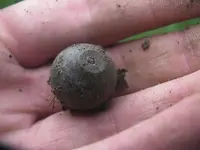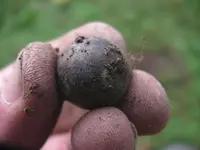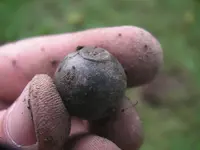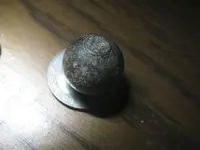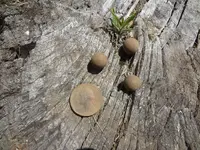There are two possible reasons why a century-old (or more) musketball can come out of the ground without showing "the usual" white-ish Lead Oxide patina. Both of the reasons involve chemistry.
1- As said above, the white-ish patina is composed of Lead Oxide. If very little oxygen reaches the lead ball, oxidation of the lead cannot occur. If the soil surrounding the bullet contains a goodly amount of water, little or no oxygen reaches the lead. I've personally dug lead bullets in wet-ground environments (or underwater) which came out of the dig-hole almost shiny lead color. An extreme example are the civil war bullets recovered by scuba divers from the bottom of rivers. Those absolutely genuine civil war bullets are difficult to sell, because they have little or no patina on them. I still own a jarful of yankee 3-groove minies found on the bottom of the Pamunkey River by a scuba-diving relichunter friend of mine, nearly 20 years ago. They've still got no patina on them (they are blackish-grey), and I still can't sell them, even though there is zero doubt that they are the real thing.
2- Although "most" musketballs (and other civil war bullets) were made of 100%-pure lead, many were not. The presence of another metal along with lead in the ball causes less Lead Oxide to form... and sometimes, very little to no patina at all. Certain varieties of civil war bullets are famous for always lacking the familiar white-ish patina... for example, Burnside bullets. They were made of what is called "hardened lead," which is a lead-alloy containing a small amount of tin or antimony, to makes the lead harder. The purpose of using hardened-lead bullets was to prevent lead buildup in the gunbarrel's rifling grooves.
I should mention, most post-civil-war bullets were made of hardened-lead, and you may have noticed that the postwar bullets you dig rarely have white-ish patina on them. Now you know why.
In summary... your no-patina musketball may have been found in "wet ground"... or, it may have been made of a lead-alloy instead of 100%-pure lead. In the musketball era, many civilians and even some soldiers tossed whatever easily meltable White-Metal scraps were handy into the pot to make bullets... pieces of broken pewter, bits of old solder, fishing-sinkers, etc. The recipe didn't matter to folks in those days, because the cast ball would still shoot just fine, regardless of whether it was made of pure lead or extremely impure lead.
